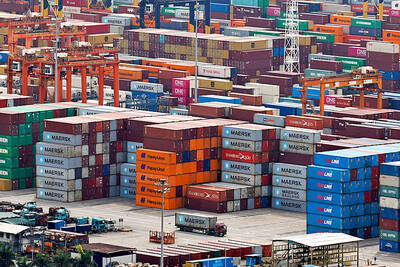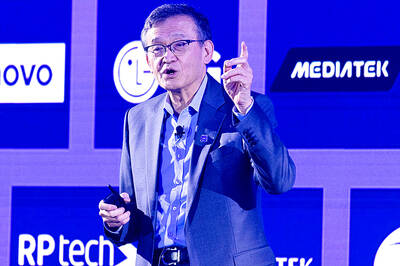At 2am, the red squiggle begins to rise. Sharply.
The workers sitting in the dimly lighted room barely look up at the white screen on the wall that tracks the deluge of unwanted e-mail to millions of In boxes. They already know it's happening.
Their computer monitors are filled with e-mail meant to appeal to the lonely and insecure: Free XXX video. Debt consolidation. Breast enhancement. Viagra. Work from home. Beat cellulite.

PHOTO: NY TIMES
It is the middle of the night on the West Coast, but spam attacks -- e-mail messages sent to multiple addresses often lumped together as "undisclosed recipients" -- are bubbling up from all corners of the Internet. Spam doesn't sleep.
Click and type. Cut and paste. Save. Export. That is how spam filters are created in the round-the-clock war room run by Brightmail, a company that performs filtering for Internet service providers like Earthlink, MSN and AT&T Worldnet as well as companies trying to keep their e-mail systems unclogged.
In the war room, the steady pulse of keyboard and mouse clicks is punctuated by brief declarations.
"I got the Viagra," calls out one 20-something employee as he clicks to create a simple filter.
"I need help on the breast enhancement," announces another.
Spammers are like fruit flies. They multiply. They are elusive. Worst of all, they evolve quickly. The most aggressive spammers have become very sophisticated, constantly varying subject lines, "from" addresses and body text.
Joe Long, a war-room employee, remembers when times -- and spam -- were simpler. Two years ago, he and his colleagues would sometimes be able to parry all the attacks and clear their to-do list. "That never happens now," Long said.
For in addition to becoming more sophisticated, spammers have become more prolific. These days, more and more junk e-mail is finding its way into In boxes.
Volume multiplies
Brightmail says that the volume of spam it encounters has almost tripled in the last nine months. The company adds that 12 to 15 percent of total e-mail traffic is spam; a year ago, that figure was closer to 7 percent. Brightmail, which maintains a network of In boxes to attract spam, now records 140,000 spam attacks a day, each potentially involving of thousands, if not millions, of messages.
Statistics like these are supported by anecdotal evidence from computer users, who report that they are seeing more and more unwanted e-mail every time they log on. Hounded by spam, some computer users have simply abandoned e-mail addresses.
Spamming is relatively simple to do -- it is not much harder to send 1 million e-mail messages than it is to send one.
But some analysts say that the increase may also result, paradoxically, from the efforts to curb spam. A kind of arms race may have developed, those analysts say: The more efforts are made to block unwanted e-mail, the more messages spammers send to be sure that some will get through.
Whatever the reasons, individual complaints about e-mail are echoed by Internet service providers, some of which say that 50 percent of incoming e-mail traffic is spam.
Consumer advocates and politicians are complaining too, and proposing new laws to fight spam. Governmental agencies are also announcing new initiatives in the battle.
Toothless fed
The US Federal Trade Commission receives 40,000 spam complaints a day at its Web site, www.ftc.gov/spam. It has an e-mail address, uce@ftc.gov ("uce" stands for "unsolicited commercial e-mail"), to which people can forward spam e-mail that they receive. To date, the FTC has collected more than 12 million such messages, which are kept in what is known as the refrigerator, a computer database in the FTC's Internet lab.
But the FTC cannot and does not regulate unsolicited commercial e-mail. There are currently no federal laws against spam.
Spam is a form of commercial speech. While commercial speech enjoys some protection under America's First Amendment, it is also subject to regulation -- but such regulation needs to be established by legislation.
Brightmail categorizes 4 percent of spam attacks as intentionally fraudulent.
Ideally, consumer advocates want the spam equivalent of the 1991 federal Telephone Consumer Protection Act, which prohibited prerecorded telemarketing calls and junk faxes. The trade commission was also given power to enforce the legislation.
A broad anti-spam law has been approved in Europe. On May 30, the European Parliament passed a ban on unsolicited commercial messaging. Electronic marketing can be aimed only at consumers who have given prior consent.
Interest groups are lobbying to tone down the strongest aspects of spam legislation in the US.
Those lobbyists are not spammers. They are some of the country's largest corporations and commercial associations: Citicorp, Charles Schwab, Procter & Gamble, the National Retail Federation, the Securities Industry Association and the American Insurance Association. The groups argue that many of the bills would unfairly restrict e-mail marketing and put electronic commerce at a disadvantage.
With little happening in Congress on anti-spam legislation, 25 state governments have taken the lead and passed a variety of spam-related laws. They range from Delaware's 1999 outright ban on unsolicited commercial e-mail to more indirect limitations. Most states ban false return e-mail addresses, require "remove me" provisions or demand labels on sex-related messages.
But enforcement remains a sticking point. Telemarketers are easier to identify because telemarketing is expensive and as a result, such companies need assets. All a spammer needs for business is a computer, an Internet connection and an inexpensive CD containing spamming software and tens of millions of e-mail addresses.
Some ISPs, including CompuServe and AOL, have filed suit against spammers to prevent them from sending unsolicited e-mail to users of those services. But using lawsuits to combat spammers is like trying to catch swarming fruit flies by hand. For every one you manage to catch, there are 10 more undeterred ones pestering you.
To date, the most effective weapon against spam is technology. "Spam requires a technology solution because it is a technology problem," said Ken Schneider, chief technology officer at Brightmail.
But even technology is limited, since spam is e-mail and e-mail is designed to flow easily. Only 5 percent of all enterprises will be able to filter 90 percent of spam in 2002, said Joyce Graff, research director at Gartner Research.
Businesses have tried to throw up all types of defenses. Many reject mail coming from computers that are known to have been hijacked for spam. Some ISP's reject e-mail sent in bulk. That often results in the rejection of legitimate noncommercial messages sent to addresses on mailing lists.
Other technological approaches limit e-mail to preapproved senders or senders who respond with a password -- approaches that slow down the transmission of e-mail. Users can also buy personal In box protectors.
Brightmail, which has one of the most sophisticated services, says the best spammers are always a step ahead of its defense mechanism. They evade Brightmail filters by randomizing the characteristics that filters look for.
"It's very difficult to fight," said Long, the war-room worker. "You get entrenched fighting it one way, and they go put a new tool against you."
For spam to disappear, a combination of coordinated international regulatory action, aggressive enforcement, software and human oversight is needed, Salem said.
The bad news is that until that magic combination comes about, spam will continue to clog In boxes. The good news is that it could help you look younger, feel more virile, become debt-free and get a college degree at home. Really.

The Eurovision Song Contest has seen a surge in punter interest at the bookmakers, becoming a major betting event, experts said ahead of last night’s giant glamfest in Basel. “Eurovision has quietly become one of the biggest betting events of the year,” said Tomi Huttunen, senior manager of the Online Computer Finland (OCS) betting and casino platform. Betting sites have long been used to gauge which way voters might be leaning ahead of the world’s biggest televised live music event. However, bookmakers highlight a huge increase in engagement in recent years — and this year in particular. “We’ve already passed 2023’s total activity and

Nvidia Corp CEO Jensen Huang (黃仁勳) today announced that his company has selected "Beitou Shilin" in Taipei for its new Taiwan office, called Nvidia Constellation, putting an end to months of speculation. Industry sources have said that the tech giant has been eyeing the Beitou Shilin Science Park as the site of its new overseas headquarters, and speculated that the new headquarters would be built on two plots of land designated as "T17" and "T18," which span 3.89 hectares in the park. "I think it's time for us to reveal one of the largest products we've ever built," Huang said near the

China yesterday announced anti-dumping duties as high as 74.9 percent on imports of polyoxymethylene (POM) copolymers, a type of engineering plastic, from Taiwan, the US, the EU and Japan. The Chinese Ministry of Commerce’s findings conclude a probe launched in May last year, shortly after the US sharply increased tariffs on Chinese electric vehicles, computer chips and other imports. POM copolymers can partially replace metals such as copper and zinc, and have various applications, including in auto parts, electronics and medical equipment, the Chinese ministry has said. In January, it said initial investigations had determined that dumping was taking place, and implemented preliminary

Intel Corp yesterday reinforced its determination to strengthen its partnerships with Taiwan’s ecosystem partners including original-electronic-manufacturing (OEM) companies such as Hon Hai Precision Industry Co (鴻海精密) and chipmaker United Microelectronics Corp (UMC, 聯電). “Tonight marks a new beginning. We renew our new partnership with Taiwan ecosystem,” Intel new chief executive officer Tan Lip-bu (陳立武) said at a dinner with representatives from the company’s local partners, celebrating the 40th anniversary of the US chip giant’s presence in Taiwan. Tan took the reins at Intel six weeks ago aiming to reform the chipmaker and revive its past glory. This is the first time Tan